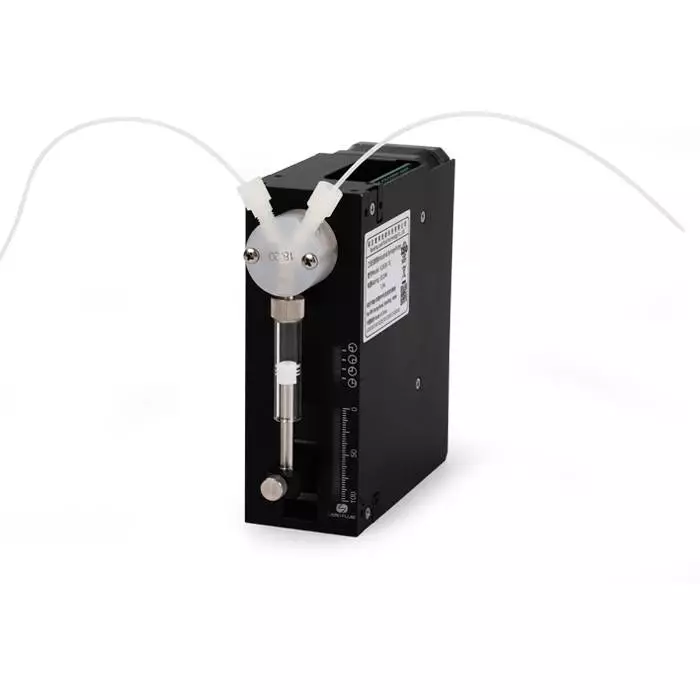What is an industrial injection pump ?And How does an industrial syringe pump work ?
An industrial syringe pump, also known as a syringe infusion pump or syringe dispenser, is a precision pumping device designed to deliver fluids with high accuracy and control. It is based on the same principle as a medical syringe, where a plunger is used to push the fluid through a narrow nozzle or needle. However, industrial syringe pumps are specifically designed for industrial applications that require precise and controlled fluid delivery.
Here are some key features and applications of industrial syringe pumps:
Features:
- High Precision: Industrial syringe pumps offer excellent precision and accuracy in fluid dispensing. They can deliver fluids in very small increments, allowing for precise dosing and dispensing.
- Programmable Control: Syringe pumps often come with programmable features, allowing users to set specific flow rates, dispensing volumes, and dispensing patterns. This programmability enables automation and repeatability in industrial processes.
- Variable Flow Rates: Syringe pumps allow for adjustable flow rates, controlling the speed at which the plunger pushes the fluid. This feature is beneficial when working with different viscosities or when a gradual or controlled flow is required.
- Compatibility with Various Syringe Sizes: Industrial syringe pumps are designed to accommodate different syringe sizes, ranging from small microliter-sized syringes to larger milliliter-sized syringes. This flexibility allows for a wide range of fluid volumes to be dispensed.
Applications:
- Laboratory and Research: Industrial syringe pumps are commonly used in laboratories and research facilities for precise fluid delivery in experiments or analytical procedures. They are utilized in areas such as chemical analysis, drug discovery, biotechnology, and life sciences.
- Industrial Manufacturing: Syringe pumps find application in industrial manufacturing processes that require accurate and controlled dispensing of fluids. This includes adhesive application, lubrication, coating, electronics assembly, and other production line applications.
- Pharmaceuticals and Biotechnology: Syringe pumps are utilized in pharmaceutical and biotech industries for precise dosing and delivery of drugs, reagents, or samples. They are commonly used in drug formulation, drug testing, microfluidics, and automated liquid handling systems.
- Food and Beverage Industry: Industrial syringe pumps find application in the food and beverage industry for controlled dispensing of ingredients, flavors, colors, or additives. They are used in processes such as flavoring, coloring, filling, and small-scale production.
- Chemical and Petrochemical Industry: Syringe pumps are employed in the chemical and petrochemical sectors for accurate and controlled injection of chemicals, catalysts, or additives into various processes. They are used in research and development, pilot plants, and production environments.
Industrial syringe pumps offer precise and controlled fluid delivery, ensuring accuracy and repeatability in industrial processes. They are designed to handle a wide range of fluids, including viscous liquids, corrosive chemicals, or sensitive materials. The selection of an industrial syringe pump depends on factors such as flow rate requirements, fluid compatibility, syringe size range, and programmability features needed for the specific application.
How does an industrial syringe pump work ?
An industrial syringe pump works based on the principle of positive displacement, where a plunger or piston inside a syringe barrel pushes the fluid through a narrow nozzle or needle. The pump is designed to precisely control the movement of the plunger, allowing for accurate and controlled fluid delivery. Here’s a step-by-step explanation of how an industrial syringe pump typically works:
- Syringe Loading: The syringe pump is equipped with a syringe holder or clamp where the syringe is securely placed. The syringe barrel has a nozzle or needle attached to its outlet.
- Syringe Calibration: Before operation, the syringe pump is calibrated to accurately determine the volume of fluid to be dispensed. This calibration ensures accurate dosing and dispensing.
- Plunger Positioning: The plunger or piston of the syringe is positioned at the starting point, typically at the bottom of the syringe barrel. The plunger is connected to a motor or actuator that controls its movement.
- Fluid Priming: The syringe pump may have a priming function to remove any air bubbles or excess fluid from the syringe and the fluid delivery path. This ensures that the fluid being dispensed is consistent and free from air pockets.
- Start/Stop and Control: The syringe pump is operated using a control interface or software. The user sets the desired parameters such as flow rate, volume, and dispensing pattern. The pump can be started, stopped, or paused as needed.
- Plunger Movement: When the pump is activated, the motor or actuator starts moving the plunger. The plunger pushes the fluid inside the syringe barrel towards the nozzle or needle. As the plunger moves, a precise volume of fluid is dispensed.
- Flow Rate Control: The syringe pump allows for precise control of the plunger movement speed, which determines the flow rate of the fluid being dispensed. The speed can be adjusted based on the desired flow rate or fluid viscosity.
- Feedback and Monitoring: Some syringe pumps have built-in sensors or feedback mechanisms to monitor the plunger position, pressure, or flow rate. This feedback helps ensure accuracy and provides real-time information about the fluid delivery process.
- Dispensing Accuracy: The industrial syringe pump ensures high accuracy in fluid delivery by precisely controlling the plunger movement, allowing for accurate dosing and dispensing. The calibration, flow rate control, and monitoring mechanisms contribute to achieving the desired accuracy.
- Completion and Repeat: Once the desired volume or dispensing pattern is completed, the pump stops or returns the plunger to its initial position. The syringe pump can be programmed to repeat the dispensing process for continuous or repetitive operations.
Industrial syringe pumps are designed to handle a wide range of fluids, including viscous liquids, corrosive chemicals, or sensitive materials. The precision and control offered by these pumps make them suitable for various applications where accurate fluid delivery is crucial.
